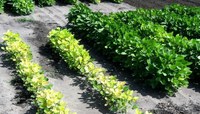Soybean Chlorosis Scores Available Online
(Click the image below to view a high-resolution image that can be downloaded)
Soybean iron deficiency chlorosis (IDC) is a major problem in the eastern part of North Dakota and northwestern Minnesota, says Hans Kandel, North Dakota State University Extension Service agronomist.
The IDC symptoms might be present during the two- to seven-trifolioate leaf stages. Plants tend to recover and start to turn green again during the flowering and pod-filling stages.
However, IDC during the early vegetative stages can reduce yield potential severely. Some varieties are more tolerant to IDC than others. For high pH soils with known IDC problems, select an iron chlorosis-tolerant variety of suitable maturity and is high yielding.
For the soybean varieties tested by NDSU in 2014, the Roundup Ready IDC and conventional / Liberty Link IDC scores are available at the NDSU variety trials result website at http://www.ag.ndsu.edu/varietytrials.
“Seed companies already are offering soybean seed for sale for the 2015 growing season, so this new IDC information is important in making the right soybean variety selection decisions,” says Kandel.
Data from the 2014 trials is based on field studies conducted at three locations that had known IDC problems. Measured was the IDC resistance of 246 Roundup Ready and 51 non-Roundup Ready, including Liberty Link, soybean varieties.
For the research, eight seeds were planted very near to each other. Soon after emergence, the number of plants were thinned to three.
Visual IDC ratings were made of the plants on a 1 to 5 scale, with 1 representing no chlorosis and 5 the most severe chlorosis. Ratings were taken at the 2- to 3- and 5- to 6-trifoliolate stages.
“Significant differences in IDC scores were observed during the testing,” says Ted Helms, who conducted the research and is the NDSU soybean breeder. “As far as we know, this is the most comprehensive evaluation available to farmers.”
“Variety selection is the number one management strategy to reduce IDC expression in the field. Farmers are encouraged to pick the most tolerant, high yielding variety for their most severe IDC fields,” says Kandel.
NDSU Agriculture Communication – Sept. 5, 2014
| Source: | Ted Helms, (701) 231-8136, ted.helms@ndsu.edu |
|---|---|
| Source: | Hans Kandel, (701) 231-8135, hans.kandel@ndsu.edu |
| Editor: | Rich Mattern, (701) 231-6136, richard.mattern@ndsu.edu |


